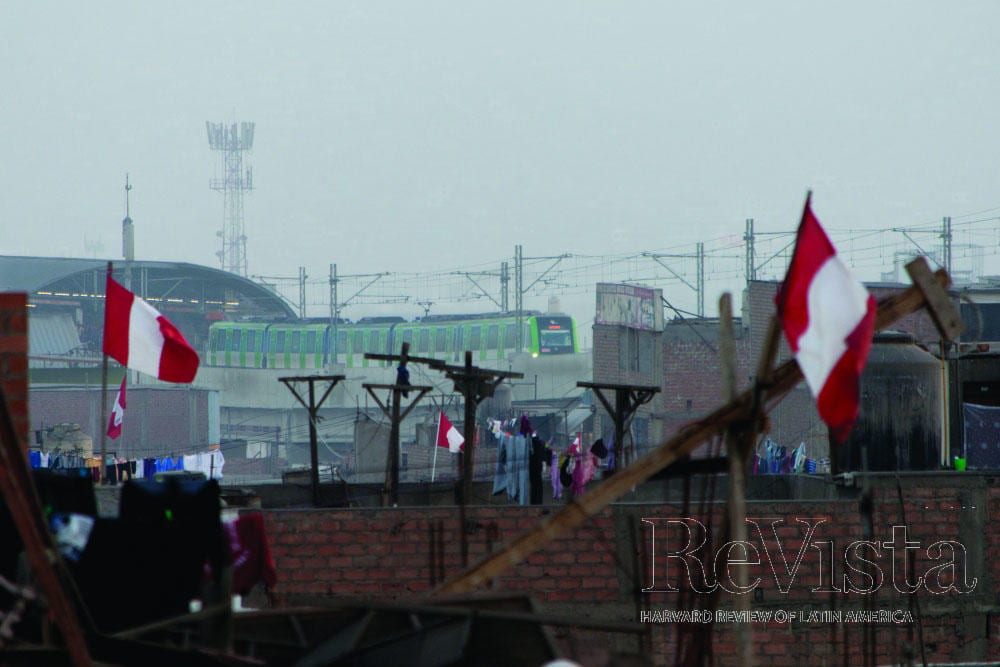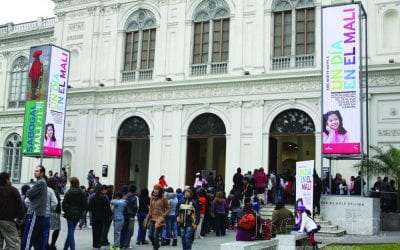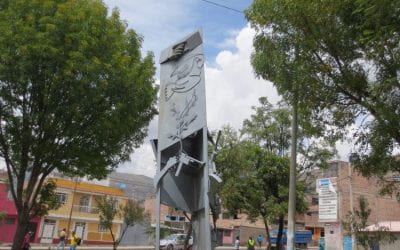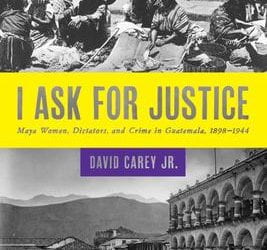Protests over Resource Extraction in Peru
Demanding Rights and Services

“El Tren desde mi azotea” (The Metro from my Roof) captures the inauguration of a new form of public transportation, a priority for environmental activists. Photo by Ademir Espiritu, Ojos Propios, Proyecto Talleres de Fotografía Participativa, Lima 2014.
In 2001, the small town of Tambogrande erupted into violent protests over concessions to a large mining company. In Cajamarca, communities affected by mineral extraction have protested repeatedly against the increasing environmental degradation in the region. Elsewhere, Amazon residents fought relocation and the commercialization of their lands by logging companies. Protests over resource extraction in Peru are common and often violent: 146 people died and scores were injured in protests in the first decade of the 21st century, according to the Peruvian Ombudsman Office. Demonstrators oppose the adverse impact of mining on their jobs and the environment, as well as how mineral wealth is distributed.
Yet one might ask why all these people are protesting—and protest over mineral resources is the most frequent source of protest in the country. After all, the extraction of natural resources in Peru has contributed to an impressive economic expansion. Record-high commodity prices as well as an aggressive Chinese demand for raw materials have contributed to this economic bonanza. Indeed, Peru’s economy has become one of the fastest growing and most stable in the Latin American region. Per capita GDP increased from US$4,459 in 1990 to US$9,421 in 2012. The share of the Peruvian population living in poverty also declined from 58.7 percent in 2004 to 27.8 percent in 2011, and the percentage of those living in extreme poverty dropped from 16.4 percent to 6.3 percent during the same period. A growing, consumer-oriented middle class has emerged from this economic expansion.
In 2011, mining exports accounted for 59 percent of the country’s total exports. And by 2010, Peru occupied a leading position in the global production of gold (as the fifth-largest producer), silver (first), copper (third), lead (fourth), tin (third) and zinc (third). Peru also stands out as having Latin America’s highest concentration of the world’s top mining companies. Presently, at least 21 percent of the national territory (approximately 26 million hectares) is under some sort of mining concession. Government officials increasingly see mining as the mainspring of national development, and it is a key source of government revenue. Given the significance of resource-based growth policies for the national economy, protesters have put elected officials in a very difficult spot politically as these leaders seek to continue the economic “good times” amid rising social unrest.
Although one could easily argue that the economic history of Peru is essentially a history of mining (its gold and silver provided the Spanish empire with an extraordinary source of wealth), large-scale mining there can be traced to the turn of the 20th century with the operations of the Cerro de Pasco Corporation (CPC), a U.S. mining company. The origins of the country’s labor movement are also tied to CPC as the company became the largest private employer in the nation. At the same time, the current wave of protests over natural resource extraction provides an ideal venue to understand the changing nature of mobilizations as a consequence of the deepening of economic liberalization policies (or “new mining” as others had called it). In particular, these mobilizations help us understand the geographic segmentation of protests as well as the emergence of broad coalitions with diverse sets of new actors.
Under “new mining,” technological conditions have reduced the need for unskilled labor, and labor disputes between mining companies and workers have become less visible. Instead, the so-called mega extractive projects (megaproyectos mineros) require more water, energy, land and landscape. New open-pit and heap-leaching techniques demand far greater access to each of these resources. Those protesting against the extraction of natural resources are largely the rural and urban populations affected by extraction. And their claims often include land, water quantity and quality, landscape and the protection of the environment and their livelihood. Seen in this light, “new mining” allows us to understand the new actors and types of coalitions that aggrieved groups have forged in opposition to extraction. These coalitions cut across social classes and the urban and rural divide, as well as environmental and nationalistic discourses.
However, not all of the mobilizations against “new mining” address the adverse impact of mining on livelihoods and the environment. The commodity price boom has yielded remarkable profits for extractive industries, and taxes collected from mining have become the most important intergovernmental transfer linked to the extraction of natural resources. In Peru, these transfers are known as canon minero. These intergovernmental transfers have also encouraged a sizeable number of mobilizations over their distribution and use across the different tiers of government—local, provincial, regional and national.
Naturally, it is not an easy undertaking for the less powerful to mount a successful opposition campaign against a lucrative extractive industry and the governments that sponsor “new mining.” Large-scale mobilizations are difficult to keep up over a long period of time and require a lot of organization and mobilization of resources. Their participants need to devote time outside of their daily routines to sustain them. Thus it is important to differentiate among the different types of mobilizations surrounding extraction. Here I propose a straightforward typology of protests, and suggest that some of these mobilizations are driven by “demands for rights,” which are encouraged by environmental concerns such as the protection of water and lands; other mobilizations are driven by “demands for services,” which arise as a consequence of disputes over the distribution and use of revenues generated from resource extraction. These differences have implications over the development of protest movements against resource extraction.
The “Bad News” of Resource Extraction: Demands for Rights
Environmental concerns in defense of the water supply or the protection of agricultural lands exemplify the mobilizations over demands for rights. Most of these protests simply oppose mining. In some cases, protesters concerned about the environment aim to prevent the mining activities from getting off the ground, as in the case of Tambogrande in the Piura region. In other cases, environmental activists seek to halt the expansion of already existing mining activities, as in Mount Quilish in the Cajamarca region. In Piura, Canadian-based Manhattan Minerals Corporation (MMC) sought to construct an open-pit mine for the extraction of gold near the San Lorenzo Valley and Tambogrande. The project called for the relocation of thousands of residents as well as the rerouting of the tributaries of the Piura River. The mobilizations against MMC extended over a period of almost five years, starting in 1999 through 2003. In Cajamarca, U.S.-based Newmont’s Yanacocha mine became the largest gold producer in Latin America, and one of the largest foreign investment operations in Peru. The Yanacocha mine began to extract gold in the early 1990s. Several years later, buoyed by high prices, it sought to expand operations to other areas, such as Mount Quilish in 2004 and Conga in 2012.
Communities often feel marginalized or excluded from the decision-making process regarding natural resource governance. This has also triggered a number of important protests, demanding consultation rights on development projects that affect indigenous people. The 2008-09 mobilization in opposition to opening the Amazon up for development in the province of Bagua is an example of protests over demands for rights: in this particular case, consultation rights. The U.S.-Peru free trade agreement signed in 2006 encouraged the expansion of the extractive frontier, and in the case of the Amazon region, the agreement sought to facilitate logging and the commercialization of indigenous communal lands. Mobilizations invoking consultation rights often incorporate an environmentalist discourse to further resist the exploitation of natural resources.
The “Good News” of Resource Extraction: Demands for Services
Protests over demands for services revolve around disputes over how wealth from extraction is distributed. These protests are not necessarily opposed to mining and often do not involve mining companies directly. Rather these mobilizations entangle local populations and political authorities representing the different tiers of government where the natural resource is extracted. These mobilizations are common in areas where mining may be the only activity that is economically viable and does not compete with other activities, such as agriculture. Regional and local governments thus seek to integrate extractive activities already present with the development of the localities in which mining takes place.
Allocation of revenues across different levels of government has changed over time. As several studies have shown, the perceived inequities in the distribution of revenues among presidents of regional governments, mayors of provincial municipalities, and mayors of district municipalities have triggered a sizeable number of protests. In terms of the use of revenues, the disputes have to do with the efficient management of resource incomes, where efficient management refers to both its proper use and the capacity of local governments to deliver improvements where resource extraction takes place. These revenues are often spent in the delivery of services or infrastructure projects such as roads, schools and health centers.
In sum, not all the mobilizations against resource extraction are created equal. On the one hand, the protests over demands for services acknowledge the “good news” of extraction, and seek a more equitable distribution of the revenues generated from mining. These mobilizations do not oppose extraction but rather seek material improvements, such as a better provision of social services, higher wages for mine workers and so on. The claims of protesters are very specific and negotiable. These mobilizations typically result in a pattern of non-stop protest whereby short-lived protests lead to small concessions, which later encourage other short-lived protests and other concessions, and so on. Protests thus become a bargaining tool to achieve political objectives or policy demands. They bring extractive industries to the negotiating table.
On the other hand, the protests over demands for rights follow the “bad news” of extraction, and seek to protect the water supply and lands from the perceived threats that are typically associated with mining. These mobilizations oppose extraction and seek to stop it. Such mobilizations raise broader claims that are more difficult to accommodate, and compared to those of protests over services, these claims are also more likely to produce organized and sustained challenges against extraction.
The distinction between demands for rights and demands for services is important. The motivations (and emotions) of protests over rights are, in fact, very different from those of protests over services. Mobilizations over demands for rights approximate the sort of economic threats that typically encourage people to participate in protest activity. In contrast, mobilizations over demands for services come close to an economic opportunity insofar as individuals mobilize to better their situation, particularly in the presence of windfall profits as a consequence of rising commodity prices. The threats associated with protests over “rights” provide, arguably, a stronger rationale for collective resistance vis-à-vis the motives tied to protests over services. This stronger rationale facilitates the types of organized and sustained challenges more likely to stimulate positive responses on behalf of aggrieved groups.
The cases of Tambogrande, Mount Quilish and Bagua are examples of protests over “demands for rights.” The organized and sustained challenges seen in these three cases have had significant national policy effects. For instance, the mobilization in Tambogrande was the first to invoke and execute a popular referendum in opposition to mining. This strategy, which was neither legally sanctioned nor authorized by the national government, has been replicated in other protests against resource extraction and with the same political objective. The mobilization in Bagua in the Amazon region forced the national governments of presidents García (2006-11) and Humala (2011-present) to recognize Convention 169 (C169) of the International Labor Organization (ILO). C169 advances consultation and participation rights on behalf of indigenous peoples on issues that affect them. Finally, the mobilization about Mount Quilish moved policy makers to support a more decentralized allocation of the canon minero that comes from extractive activities.
Related Articles
The Violence of the VIP Boxes
English + Español
In Peru, the upper class does not like to mix with those they consider different or inferior. Their maids on the beaches south of Lima are not allowed to swim in club pools and, sometimes, not even in the ocean. The VIP boxes at sports and theater events maintained by the government are a public display of a private practice that reproduces in the public sphere the worst aspect of private hierarchical structuring.
Peace and Reconciliation
English + Español
Eleven years have gone by since the Peruvian Truth and Reconciliation Commission presented its final report. The report reconstructed the history of many cases of massacres, tortures, murders and other serious crimes. At the same time, it contributed an interpretation of the…
I Ask for Justice: Maya Women, Dictators, and Crime in Guatemala, 1898–1944
On May 10, 2013, General Efraín Ríos Montt sat before a packed courtroom in Guatemala City listening to a three-judge panel convict him of genocide and crimes against humanity. The conviction, which mandated an 80-year prison sentence for the octogenarian, followed five weeks of hearings that included testimony by more than 90 survivors from the Ixil region of the department of El Quiché, experts from a range of academic fields, and military officials.




